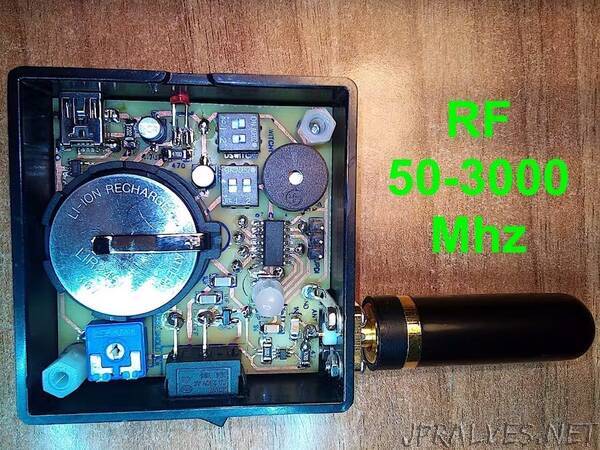
“A wide range RF detector 50-3000Mhz with battery charger, ATtiny micro controller and SMD.
The RF detector can be used as linear instrument monitor or as threshold/comparator alarm, it depends from DipSwitch1-1 setting: On=instrument, Off=comparator. The threshold level comes from 10K trimmer you may set as you like. In instrument mode both buzzer and top panel RGB LED change their level (sound & light) depending of the detected RF power level. DipSwitch1-2 setting: On=buzzer on, Off=buzzer off.
By the way of DipSwitch2-1 and DipSwitch2-2 you may change the colour of the top panel RGB LED: 00=off 01=red 10=green 11=blue.
Additionally it is an USB mini connector to recharge the battery from an USB power source, and a red colour LED to show when it is charging.
Inspired from John Bradnam’s ATtiny 1614 Project I bought a couple of this microcontrollers to take a new way and enjoy a new adventure, I made MyTiny first testing circuit. Everything is working on my choice to power it at 3.3v. Up to today I tested and verified: digitalRead, digitalWrite, analogRead, analogWrite both PWM and DAC; I provided a serial monitor though pins RX/TX <-> FTDI serial interface and SoftwareSerial library; finally I connected an OLED 128x32 display by the way of SDA/SCL and Wire library. Cool!
Components list:
- LT5534 50-3000Mhz RF power detector IC
- ATtiny 1614 3.3V MCU
- LIR2450 3.6V rechargeable battery + PCB holder
- MCP73831 Li.Po. controller charger IC
- Active buzzer
- 2x two dipswitch
- 10k trimmer
- RGB 4 pins led
- Red led
- SMA-M (144-430Mhz small antenna)
- SMA-F panel connector, square + screws
- On/off switch
- 2x SMD 4.7uF capacitors
- 2x SMD 1nF capacitors
- 2x SMD 1.0uF capacitors
- SMD 10k resistor
- SMD 22k resistor
- SMD 47 resistor
- SMD 100pF capacitor
- SMD 470 resistor
- SMD SOT-23 662K 3.3V voltage regulator IC
- 3 pins connector for UPDI (1=UPDI, 2=3.3V, 3=GND)
- SMD USB-mini connector
- Plastic or metal box 51x51mm internal size
- 9x copper pass through rivets”
